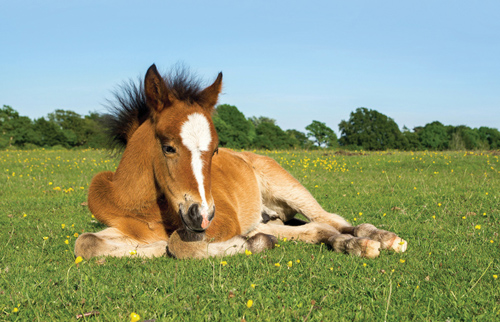 Checking your mare every day and thinking the long awaited arrival of your new foal may be near?
Checking your mare every day and thinking the long awaited arrival of your new foal may be near?
Raising babies can provoke excitement, hope and bliss from the possibility that a truly special foal may be born.
On the flip side, many complications can occur during foaling and after birth. So while breeding is not for the faint of heart, understanding what to do when your mare says it’s time to go can be absolutely critical to the life of your newborn.
Seasoned breeders share their knowledge of signs of pre-foaling and offer their advice on what materials to have on hand for the delivery and when it’s time to call for help.
 The Vet
The Vet
Gregory K. Ballard of Stephenville, Texas graduated from the University Of Illinois College Of Veterinary Medicine and has been in private practice for 23 years. He typically looks for specific signs in mares prior to foaling like relaxation and edema of the vulva, relaxation of the pelvic ligaments, enlargement of the udder and waxing of the teat ends.
“In the past few days before foaling the udder usually becomes very enlarged,” Ballard says. “This is also the time that waxing usually appears on the teat ends but this is variable and can occur a few weeks before foaling or sometimes not at all. When the mare is less than hours to a few hours from foaling, she may show signs which are very similar to a horse that is having an episode of colic. These signs may include getting up and lying down frequently, sweating, raising her tail up and down and frequent urination. Once the water breaks then the mare usually delivers the foal within 30 minutes.”
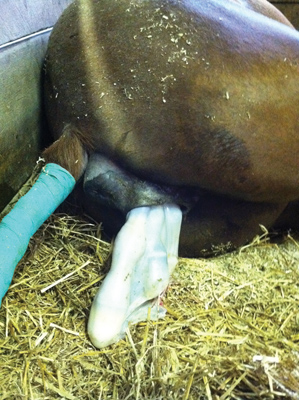
Stage 1
Ballard explains that the average length of gestation in a mare is 335-342 days. He also recommends making sure any Caslicks have been removed from the mare’s vulva before foaling. He suggests consulting with your veterinarian before foaling season to discuss the appropriate supplies to have on hand for your individual level of experience.
Supplies he generally recommends mare owners have on hand include: clean dry towels, disposable gloves, sterile OB sleeves, 2 percent chlorhexadine solution diluted to 0.5 percent for dipping navel, empty syringe case or similar device for dipping navel, stainless steel bucket, liquid dish washing soap, OB lubricant, OB chains and handles, vet wrap or gauze for wrapping tail, sodium phosphate enema, umbilical clamp, thermometer, scissors, flashlight, baling twine or similar small cord for tying up placenta, plastic trash bag, cotton rolls and emergency contact phone numbers posted so they are easily accessible.
Based on the mare owner’s experience, Ballard may also suggest other good supplies to have on hand like blood collection tubes and needles, frozen colostrum, oxygen tank and mask and an Ambu-bag with nose cone.
After a foal is born, Ballard suggests drying the foal ifnecessary, making sure the foal is alert and breathing normally, dipping the umbilical stump with chlorhexadine once the umbilical cord is detached and tying the placenta up to a level above the mare’s hocks to prevent the mare from tearing the placenta.
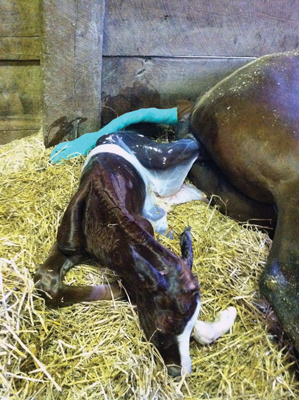
Stage 2
“Monitor mare and foal to make sure everything is progressing normally,” Ballard says.” Make sure the foal is nursing so that it receives colostrum within two hours of birth. Also, make sure the mare passes the placenta within three hours and if so put it in a plastic bag for examination to make sure all of the placenta was expelled.”
Ballard likes to conduct a veterinary check on foals between 12-24 hours after the foals are born to make sure everything is ok with the foal. He always advises mare owners to call him if they are not sure if the foaling process is proceeding normally. For example, after a mare’s water breaks they should foal within 30
minutes. If the delivery is taking longer than that or if the progression of foaling ceases, contact your veterinarian immediately.
“The soles of the hooves should be directed downward when they appear through the vulva. If they are directed up then the foal is upside down and immediate assistance is required,” Ballard says. “When the feet and nose are presented they will be surrounded by a whitish membrane. If they are surrounded by a reddish membrane, then this is called a red bag and needs to be cut so the foal will be able to breathe.”
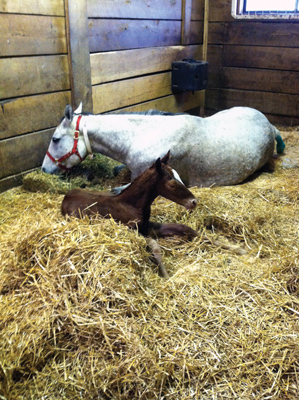
Stage 3
According to Ballard, foals should be breathing normally within a minute after foaling, should stand within an hour, and nurse within one to two hours. If the foal is unable to do any of these normal tasks then assistance from a vet is necessary.
“Bleeding from the umbilical cord should also be stopped as soon as possible,” Ballard says.
“Another common emergency is retained placenta. The mare normally expels the placenta within 30 minutes to three hours of foaling. If the placenta is still retained after three hours then this needs to be treated as an emergency. Uterine prolapse, colic and bleeding from the vulva are some other emergency situations. As always, if the mare or foal are showing any signs of distress or abnormal behavior then call
your veterinarian. It is better to consult with your veterinarian as soon as possible if you suspect something is abnormal, rather than wait and compromise the mare or foal’s health.”
Remaining calm and quiet around the mare during and after foaling is imperative to Ballard and he prefers that mares are not disturbed unless a certain procedure needs to be performed.
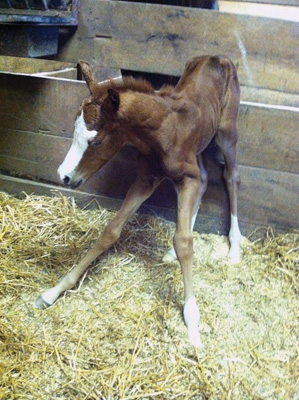
Stage 4
“Only assist the mare during foaling if needed,” Ballard says. “Make sure you are well educated in the normal foaling process and how to assist the mare in delivery of the foal. It is very important that the mare and foal bond with one another and excessive disturbance during this time could lead to the mare rejecting the foal. Another important thing that a mare owner should not do is cut the umbilical cord. Let the cord separate naturally.”
In addition, Ballard strongly urges mare owners to have their mares in good body condition several months before she foals to ensure an easy transition to getting their mare bred back after she foals.
“Proper nutrition is critical before and after foaling not only for the mare but also for the foal,” Ballard says. “A mare in poor body condition will use all of her energy to support the foal and consequently reproduction will suffer. Consult with your veterinarian on body condition scoring your mare several months before foaling so that any feed adjustments can be made.”
The Breeding Farms
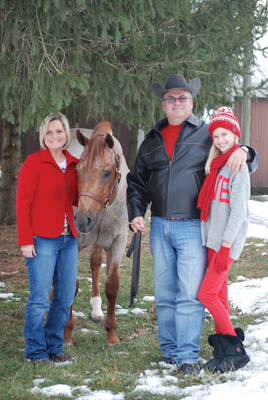 Karen Boxell of Auburn, Illinois has been the breeding manager at Richland Ranch, home of Zippos Mr Goodbar and Coats N Tails for the past 18 years after her husband, John was hired as the ranch’s manager. Richland Ranch specializes in equine reproduction, embryo transfer, and stallion management. Boxell usually foals out 50 to 75 mares a year but this year is downsizing to about 25.
Karen Boxell of Auburn, Illinois has been the breeding manager at Richland Ranch, home of Zippos Mr Goodbar and Coats N Tails for the past 18 years after her husband, John was hired as the ranch’s manager. Richland Ranch specializes in equine reproduction, embryo transfer, and stallion management. Boxell usually foals out 50 to 75 mares a year but this year is downsizing to about 25.
“I keep a history of all mares that have foaled out here,” Boxell says. “They are not always the same but it helps to know what they have done in the past. The most common sign the mare is getting close is the wax they produce on their nipples. This usually occurs about one to two days prior to foaling but again not all mares get this or have read the book on standard.”
Boxell also watches for softness in the hip area. Once the mare has gone into labor, Boxell explains mares will usually pace their stall, start to sweat and become uncomfortable enough that they might even dig a little.
“It is not unusual in the early stages of labor for the mare to get up and down several times,” Boxell says. “She is usually repositioning the foal or could be just uncomfortable. Once the mare lays down the water breaks or her allantochorion ruptures and the allantoic fluid is released. I will wait up to 20 minutes from the time the water breaks until you see the white amniotic membrane before getting nervous that there could be something out of position.”
Boxell warns of red bag deliveries if the membrane is red instead of white and urges owners delivering their foals to not hesitate to intervene and rupture it because the foal is in danger of suffocation. If the membrane is white but Boxell does not see a foot after 15 minutes she will typically glove up and determine the position of the foal.
“If I do not feel two feet and a nose, I will give the vet a call,” Boxell says. “We might be looking at a dystocia and time is of the essence to get a healthy outcome. We will usually have at least one dystocia a year. I feel it is a numbers thing. On the average, we have a great success rate of healthy foals.”
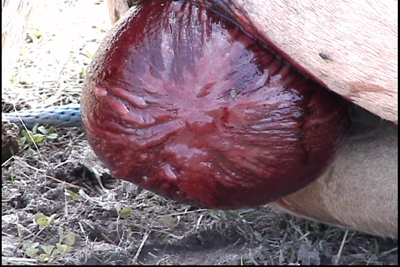 Boxell suggests having towels, a bucket with warm water to wash udder, straw for bedding, a tail wrap for the mare, naval dip, latex gloves, enema, scissor or something sharp in case of a red bag and a cell phone with vet’s number on speed dial all in her foaling kit.
Boxell suggests having towels, a bucket with warm water to wash udder, straw for bedding, a tail wrap for the mare, naval dip, latex gloves, enema, scissor or something sharp in case of a red bag and a cell phone with vet’s number on speed dial all in her foaling kit.
After the baby is first born, Boxell gives the foal an enema and dips the baby’s naval. She usually tries to get all that out of the way before the foal wants to stand. If the foal has not stood within an hour, she takes it as a sign something is wrong just as if a baby not wanting to nurse within an hour of standing. In addition, she suggests washing the udder prior to the foal nursing to reduce the risk of neonatal septicemia.
“A foal IGG test is suggested in 24 hours after birth to make sure it has gotten adequate immunity from the colostrum in the milk. If the foal appears at all lethargic it is a cause for concern,” Boxell says. “If foaling out a maiden mare, it is important to monitor the behavior of the mare after foaling. There are times she might not accept the foal right away and you might have to intervene.”
At Richland Ranch, foaling season usually lasts from Jan. 1 to May but Boxell would prefer to have early foals because they seem less susceptible to illness in the summer months.
“If the foals are late or May babies, they tend to be more susceptible to illness in the heat of the summer,” Boxell says. “I like to turn mares and foals out at night and bring them in out of the sun when we get temps up past 90 in the summer.”
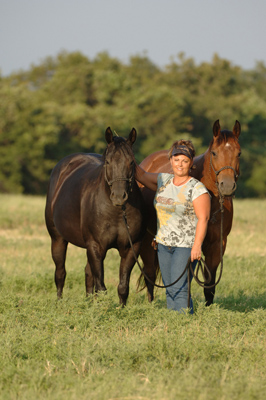 Cindy McCraw of Riverside Ranch, Sultan, Washington stands AQHA stallion My Final Notice. Through the years, she has foaled hundreds of mares out and had the pleasure of owning and standing leading sires Dynamic Deluxe and Dynamic In The Dark as well as standing many other outside stallions. At a young age, McCraw became the protégé of Virgean Miller, who was the pioneer of horse breeding and foaling in the Northwest. Her passion for reproduction lead McCraw to study equine reproduction at Meredith Manor Equestrian College and Colorado State University.
Cindy McCraw of Riverside Ranch, Sultan, Washington stands AQHA stallion My Final Notice. Through the years, she has foaled hundreds of mares out and had the pleasure of owning and standing leading sires Dynamic Deluxe and Dynamic In The Dark as well as standing many other outside stallions. At a young age, McCraw became the protégé of Virgean Miller, who was the pioneer of horse breeding and foaling in the Northwest. Her passion for reproduction lead McCraw to study equine reproduction at Meredith Manor Equestrian College and Colorado State University.
“The first foaling that I ever assisted with was in 1979. I was 15 years old when my mother’s mare was bred as a family fun project. I was hooked. My career was started down the path of equine reproduction,” McCraw says. “In my experience, over 90 percent of mares will foal without complications but you must always be ready for that other 10 percent.”
To McCraw, the most important and exciting time of the year is at foaling time. She feels a real responsibility to be there when a mare foals.
“Although many people have had good luck going out and finding a foal next to its mom in the morning, it is absolutely critical to me that every birth is attended,” McCraw says. “I cannot tell you how many times every year that I receive a phone call from a devastated mare owner who has found their foal dead due to a foaling complication which could have possibly been avoided if assistance had been available. It is just heartbreaking.”
To help prepare her mares for a safe delivery, McCraw starts months in advance getting mares used to their bellies being rubbed and their udder and teats being handled. When a mare gets within 30 days of foaling, McCraw starts a bag check in the morning and at night.
“The bag check entails a quick check of the color of fluid from the mare’s teats,” McCraw says. “In my experience, in the days before foaling the color of the milk will let you know approximately when the baby is coming so that you do not end up with too many sleepless nights. For several weeks before foaling the mare’s bag is too firm to excrete any fluid. Then, you will start to notice the bag softening and should be able to squeeze a clear fluid out, and then it will be followed by a yellowish fluid. When the fluid starts to get thicker, sticky feeling, you will then find that the fluid has turned a slightly white milk color. This when the mare must have 24 hour per day monitoring as within days the milk will turn pure white and the foal will in most cases be born within 12 to 48 hours.”
The bag check system has saved a lot of sleep for McCraw through the years and foal’s lives as well, although she stresses that the system is not fool proof. Sometimes a maiden mare will carry a foal without milk and an older mare can carry white milk year round she explains and urges to not totally rely on foaling cameras either.
“I still hear the sad stories of, ‘I checked the camera every hour,’ but despite that you can find the foal dead or the mare in a situation where it is too late to provide help,” McCraw says. “I am a huge believer of the Foalalert system and for the past 20 years I have used this system for every foaling. This is a small unit that is sewn to the mare’s vulva and when set off by presentation of the foal it sets off an alarm and is programmed to also call you by phone. Along with watching for relaxed muscle tone around the tail which starts happening about two weeks prior to foaling and elongation and puffiness of the vulva area one or two days before foaling, I still go through the procedures of the bag check. When the mare’s milk turns cloudy I suture the unit on and can go about my daily chores or family dinner knowing that I will receive notification. I really feel that if people are serious about breeding and will be doing it more than once that this is great protection for your investment and your precious cargo along the way.”
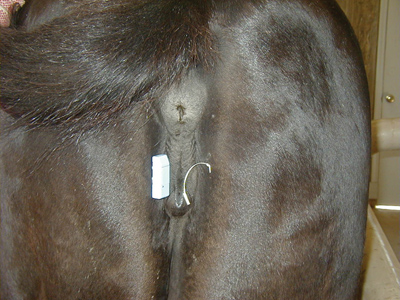 She looks for a foal’s shoulders and chest to pass then she will immediately squeeze down the muzzle to clear any mucous from the nostrils. Then, she likes to get the foal sitting sternal by pushing it into an upright position even if the foal’s hind legs are still in the mare. This can help ensure that the foal clears the fluid from its lungs and does not aspirate any of the amniotic fluid she explains.
She looks for a foal’s shoulders and chest to pass then she will immediately squeeze down the muzzle to clear any mucous from the nostrils. Then, she likes to get the foal sitting sternal by pushing it into an upright position even if the foal’s hind legs are still in the mare. This can help ensure that the foal clears the fluid from its lungs and does not aspirate any of the amniotic fluid she explains.
“When the mare is ready to get up the umbilical cord is broken, at that very point I quickly make sure that the cord does not continue to bleed after it has been severed in which case it will need to be tied or clamped off and then I iodine or Nolvasan the cord,” McCraw says. “Trying to dip the end of the cord can lead to spills or spraying too much on the foal’s skin and can cause irritation. I prefer to have a piece of shammy cloth soaked in the iodine and using an exam glove I just squeeze and massage it out onto the stump of the foal’s cord.”
From there, McCraw likes to give the baby some time to get on its feet and start the nursing process. She feels it is absolutely essential to make sure the baby gets the mare’s first milk because it is colostrum that will create immunity the foal needs. She also recommends giving your newborn a nice warm enema to help it pass its meconium, the sticky black manure.
“If your foal did not get the needed values you should have your vet administer a plasma serum to make sure you will not end up with a sick foal,” McCraw says. “Many people do not realize they can purchase a refractometer that will read the levels of colostrum with a simple little two drops of the mare’s milk. The cost of this useful tool is less than $100 and you can use it for years to come. It will at least let you know that your foal will be safe in the top ranges and if it is very poor you can contact your vet.”
With so many years in the business, McCraw has experience with turning foals, unlocking elbows and pushing a head back into retrieve legs if a problem presents itself, but she strongly advises owners who are new to the foaling process to have a plan in place in advance with their veterinarian in case assistance is needed. Although she likes to let her mares do their own work pushing, she will assist the mare if she feels she needs some help. She also suggests only pulling while the mare is pushing and then remaining quiet when the mare rests.
“I like to see a mare expel the placenta within a half hour. If the mare has not done this within two hours I give small amounts of Oxytocin every half hour,” McCraw says. “At the four hour mark if the placenta still has not come out I will lavage and manipulate it out which is something you will want your vet out to do. You can tie the placenta in knots to let its own weight help work it out but do not attempt to just pull it out or you could tear the mare or tear the placenta losing pieces back inside the mare to cause a nasty infection later or even end up with a toxic animal.”
McCraw likes to keep an organized and easily accessible foaling kit on hand that she can even carry into the foaling area if needed. She likes to keep sharp, clean scissors to cut the Foalalert unit from the mare, sterile gloves and lube to check presentation, twine or clamps to tie off a bleeding umbilical cord, towels to squeeze the fluid out of the foal’s nostrils as well as wipe down the foals’ face and body, cold night blankets to keep the foal covered before it is able to get up, a cell phone and the veterinarian’s phone number ready to dial, and foaling chains or cord in case you need to retrieve a leg.
“In rare cases after foaling the mare may require sedation and/or Banamine. If you usually have these things on hand make sure that you have discussed the dose and uses with the vet before administering them,” McCraw says. “In most cases for the first time breeders the veterinarian will attend to the mare if any problems arise. I also have a foal resuscitation unit in case the foal is not breathing at delivery. Although not common, I have saved a few foals’ lives by having it nearby.”
McCraw really believes that where you live and the facility you have really dictates whether it’s better to have early or late foals. If you live in a colder climate, she prefers having later babies so that babies can run and play hard outside, but when she lived in Texas she preferred to have earlier born foals because of the excessive summer heat.
“I would advise the typical mare owner to take advantage of the years of experience that your stallion owner/breeder has and call on them for their knowledge at each stage of this process,” McCraw says. “Most breeders are very happy to share and help you along the way as they typically are promoting their stallion and every baby is just as important to them as it is to you.”
The Home Breeders
 Jan Pittman of Chipley, Florida has been an AQHA breeder for over 10 years. She also serves on the AQHA Amateur Committee and owns Pittman Ranch where Kyle DeFreece is on staff as her trainer. Among some of Pittman’s successful foals is World and Congress Champion, Ona Good Impulse, who Pittman showed herself to two AQHA Select World Championships. She has also raised a few high selling yearlings including one of the highest sellers at the Reichert Sale.
Jan Pittman of Chipley, Florida has been an AQHA breeder for over 10 years. She also serves on the AQHA Amateur Committee and owns Pittman Ranch where Kyle DeFreece is on staff as her trainer. Among some of Pittman’s successful foals is World and Congress Champion, Ona Good Impulse, who Pittman showed herself to two AQHA Select World Championships. She has also raised a few high selling yearlings including one of the highest sellers at the Reichert Sale.
Typically, she raises five to six foals each year with a primary focus on Western Pleasure foals. Living in Florida, Pittman prefers to have her babies born early in the year because of the warm climate.
“In December, we test check my Foalalert alarm, order a new Predict-A-Foal, order straw (hard to find in my area), and resupply my foaling kit,” Pittman says. “We strip down the foaling stall and disinfect the entire area. The foaling cameras are checked and we schedule the vet to remove Catslick and suture the Foalalert transmitter. The mares udder is washed and we post a ‘to do’ reminder list for the staff.”
Some of the items in Pittman’s foaling kit include: flashlight, clean towels, sterile lubricant, garbage bag for placenta, scissors, Banamine, Oxytocin, cotton string, gloves, OB sleeves, tubes of Foal Response, resuscitation kit, tubes of Bio-Sponge, navel wash, thermometer, stethoscope, vet wrap, enemas and an emergency number for the veterinarian.
“About two weeks from the anticipated foaling date we check the mare every day,” Pittman says. “We check her udder for signs of bagging up, check to see if her croup muscles are softening, watch for waxing teats, and note any changes in her abdomen and vulva. The mare will exhibit behavioral changes such as rubbing her tail, sweating, refusing to eat or drink water, etc. Last week, I checked a mare that was two weeks from her due date. She showed all the signs for early delivery. A colt was born that night!”
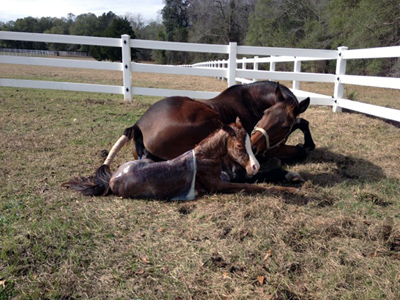 Pittman suggests not interfering with the birthing process and watches the foaling from the camera monitor in the office to ensure all is going as planned. However, she does have her vet’s cell phone number on speed dial and strongly recommends calling the vet immediately at the first sign of a complication.
Pittman suggests not interfering with the birthing process and watches the foaling from the camera monitor in the office to ensure all is going as planned. However, she does have her vet’s cell phone number on speed dial and strongly recommends calling the vet immediately at the first sign of a complication.
“Once the foal is born, we go to work,” Pittman says. “This can range from tying a knot in the amnion to vigorously toweling off the newborn. With that being said, when things go bad, they will go bad fast. So if one is not experienced, taking the mare to a facility that specializes in foaling out should be a strong consideration.”
If Pittman is going out of town, she does send her mares to a veterinarian but the majority of her foals are born at the ranch. In one instance, she had a mare that a history of complications so this particular mare was sent to a nearby veterinary facility for foaling. She explains that this mare did end up requiring a C-section and unfortunately the foal did not survive.
“If all goes well, watching a foal being born is an amazing life experience,” Pittman says. “Anyone about to experience this blessed event should speak to the vet, talk to fellow horsemen about their experiences, and take the time to read articles and books about the subject. Two books we have our staff read are Blessed Are the Broodmares and Blessed Are The Foals both by M. Phyllis Lose VMD. They are great reads, so easy to understand. Last but not least, remember to have a bottle of chilled Cristal on hand to celebrate!”
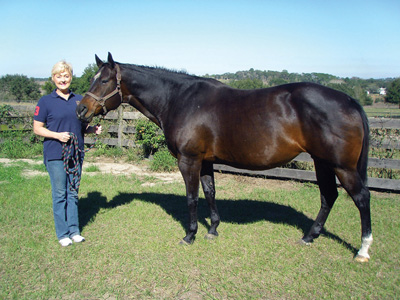 For the last 20 years, Linda Smit of Howey- in-the Hills, Florida has been caring for her own horses. Having been fortunate enough to show and own many great show horses who have amassed hundreds of points and top honors at the APHA World Show including a Reserve World Champion, Smit decided in 2010 to purchase two-time APHA World Champion stallion Joses Real Deal.
For the last 20 years, Linda Smit of Howey- in-the Hills, Florida has been caring for her own horses. Having been fortunate enough to show and own many great show horses who have amassed hundreds of points and top honors at the APHA World Show including a Reserve World Champion, Smit decided in 2010 to purchase two-time APHA World Champion stallion Joses Real Deal.
“Before I purchased my stud in 2010, I was always interested in genetics and ultimately breeding my own,” Smit says. “I diligently studied bloodlines for about a year and then bought my first three mares and started breeding at first to outside stallions about eight years ago. My main goal was to improve the breed not as a money making venture in the beginning. The ultimate goal was to eventually have my own stallion and put great foals on the ground and to raise and show my own someday.”
Joses Real Deal stands at Smit’s long time trainers David Kirk and Carole Vetto’s farm, Cedar Stone Acres in Oxford, Florida. At her own place, Painted Willow Farm, Smit typically raises two to three foals a year and concentrates on Western Pleasure and all-around disciplines.
“We try to have early spring foals as the farms in Florida have better winter weather and thus the foals are stronger than late spring foals and can get started, if appropriate, earlier,” Smit says.
Smit looks for signs of bagging up, distention of the teats, waxing, vulva relaxing, visible dripping, and changes in position of the foal.
“Foaling mares is not something to just jump into. I’ve had lots of great advice prior to doing it myself, been around my mares foaling at the other farm, working closely with my breeding vet, and for sure you have to have your vet’s phone number on speed dial,” Smit says. “You can lose a foal, mare or both in minutes if major trauma arises.”
Smit’s older, more seasoned mares are fairly predictable so she usually keeps them home to foal out but if she has a maiden mare or a mare she has no history on she may send them out to her trainer’s barn to foal out.
“I always follow the 1-2-3 rule after foaling. The foal should be up and standing in the first hour; nursing readily the second hour and watch for the meconium. By three hours, the mare should have passed the placenta,” Smit says.
Smit recommends saving the placenta for the vet to examine. She also has her vet come pull blood on the foal to make sure it has the right start and also likes to give the foal Probios at birth and on day four. She firmly believes in worming her mares 30 days prior to foaling and also giving her mares a full set of vaccinations 30 days prior to foaling as well to help set the foals immunity.
“Remember your foal will be 75 percent of its mother,” Smit says. “Surround yourself with experienced people first, have a great breeding vet and always be prepared. Start your program for success weeks prior to birth, have your supplies ready and again be a short distance and phone call away from your vet. Having a foal and participating in the process can be a wonderful, magical experience. It has been for me.”



You must be logged in to post a comment Login